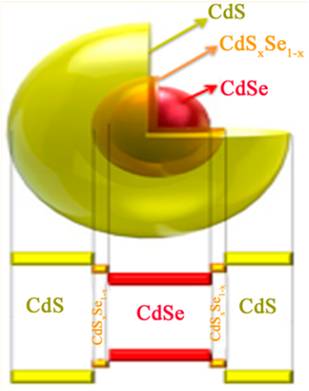The scientific paper by members of the Brazilian community on Materials research featured this month is:
Anielle Christine A. Silva, Sebastião W. da Silva, Paulo C. Morais, and Noelio O. Dantas. Shell thickness modulation in ultrasmall CdSe/CdS(x)Se(1-x)/CdS core/shell quantum dots via 1-thioglycerol. ACS Nano, 2014 Feb 25; 8(2):1913-22. DOI: 10.1021/nn406478f.
Ultrasmall crystals with modulated shell thickness.
When Professor Noelio Oliveira Dantas, at the Brazilian Federal University of Uberlândia (UFU), had the idea of a new chemical method for the synthesis of quantum dots (semiconductor crystals with only a few nanometers of size), he was studying ways to synthesize the tiny crystals aiming to biotechnological applications.

However, the results exceeded the initial expectations. In addition to produce ultrasmall quantum dots, composed, basically, of a cadmium selenide (CdSe) core and a cadmium sulfide (CdS) shell, the new method, which is cheap and highly reproducible, was a surprise because of its capacity to modulate the quantum dots’ shell thickness, an innovation compared to other known routes.
The study was developed during the PhD research that Anielle Christine Almeida Silva develops at the Physics Institute at UFU, under Professor Dantas supervision. Some results of the research were published this year by the journal ACS Nano, in an article signed by the PhD student and her advisor, jointly with two collaborators from University of Brasília, who contributed with the characterization of the quantum dots using Raman spectroscopy, and took part discussing the results.
The paper
“The main scientific contribution of this article is the proposal of a new synthesis route, via an aqueous solution, which allowed the modulation of the CdS shells’ thickness in CdSe ultrasmall quantum dots, depending on the concentration of 1-thioglycerol”, summarized Anielle. More precisely, the researchers discovered that, while smaller concentrations of 1-thioglycerol limit the growth of the cores of the quantum dots, larger amounts of the compound promote the modulated growth of their shells.
The produced ultrasmall crystals had less than 2 nm in the core, and from 0.50 to 1.25 nm in the shell. In order to calculate these dimensions from Raman spectra, the authors of the article used a model of phonon confinement with modifications proposed by themselves and another author in an article published in 2013 (Anielle Christine Almeida Silva; Ernesto Soares de Freitas Neto; Sebastião William da Silva; Paulo Cesar de Morais; Noelio Oliveira Dantas. Modified Phonon Confinement Model and its Application to CdSe/CdS Core-Shell Magic-Sized Quantum Dots Synthesized in Aqueous Solution by a New Route. Journal of Physical Chemistry. C, v. 117, p. 1904-1914, 2013.).
Regarding the biotechnological application initially expected, the authors explain that such quantum dots obtained with the new route are promising due their capacity to be easily dispersed in aqueous environments. According to the scientists, the structure of the produced ultrasmall crystals, which is similar to a sandwich with two slices of bread and a fine filling, may contribute to a higher quantum efficiency and stability in biological environments.
